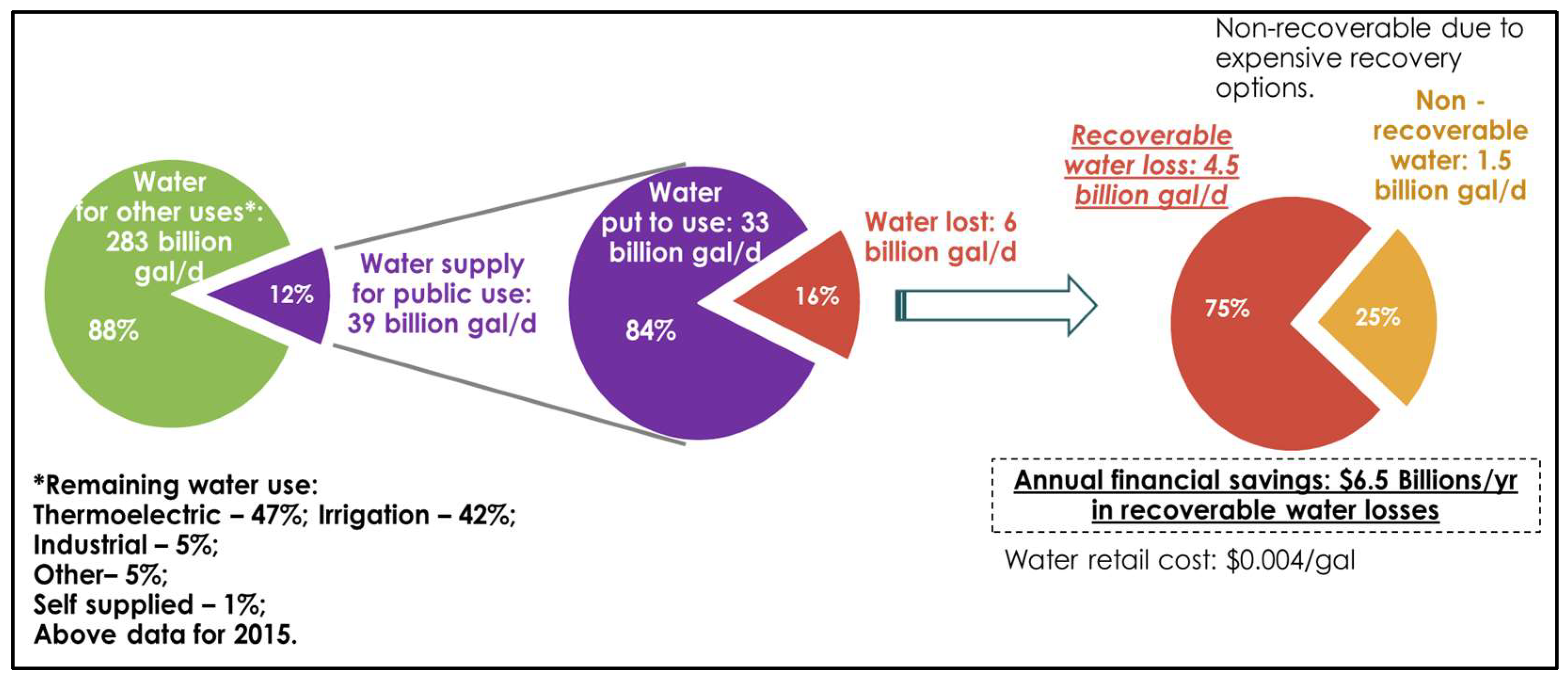Evaluating Acoustic vs. AI-Based Satellite Leak Detection in Aging US Water Infrastructure: A Cost and Energy Savings Analysis †
Abstract
Highlights
- In a case study in Atlanta, Georgia, conventional acoustic leak detection was observed to be more cost-effective than AI-assisted satellite leak detection, generating USD 2.4 million in net benefits—50% higher than the satellite approach—over a 3-year period.
- On a national level, preventing water loss may result in cost savings of USD 6.5 billion/year and achieve energy savings equivalent to 0.26 million US homes/year.
- Smart sensing technologies should be evaluated carefully based on cost, scale, and deployment context; while AI/satellite tools are promising, conventional methods may still be cost-optimal in some cases.
- Improvements in water infrastructure nationwide could significantly contribute to economic savings, energy efficiency, and smart living goals.
Abstract
1. Introduction
1.1. Literature Review
1.1.1. Real Water Loss and Its Components
- Background leaks: Water leaks occurring at low flow rates that cannot be detected via conventional acoustic leak detection equipment nor are visible above ground surface but can only be reduced via pressure management or replacement of pipes. Owing to their low leakage rates, background leaks are not a significant contributor of the amount of water being leaked through the distribution system.
- Reported leaks: Highest water leakage rates of all three leakage types and easily visible above ground and therefore can be repaired and mitigated within a small typical duration of 3–8 days [9].
- Unreported leaks: Water leakage rate lies between the values of reported and background leaks, but water quantity lost is higher owing to their low visibility above ground. These leaks have longer repair time and can be detected via acoustic leak detection technique.
1.1.2. Traditional Water Leak Detection Technologies
1.1.3. Advanced Water Leak Detection Technologies
1.1.4. Economic Models for Water Infrastructure
1.2. Objectives and Scope
2. Methodology
2.1. Case Study Description and Data Sources
2.2. Economic Analysis Methodology to Mitigate Unreported Water Leaks
2.2.1. Data Collection
2.2.2. Estimation of Water Loss Reduction and Infrastructure Leakage Index (ILI)
2.2.3. Estimation of Water Survey and Repair Costs
2.3. Estimation of Economic Leakage Level of Water
2.4. Uncertainty Analysis of Conventional Acoustic Leak Detection Technology and Advanced Satellite Leak Detection Technology
2.5. Domestic Comparison of US Water Loss Against Germany and The Netherlands with Financial and Embodied Energy Savings
3. Results and Discussion
3.1. Estimation of Economic Level of Leakage for Conventional Acoustic Leak Detection Technology
3.2. Estimation of Economic Level of Leakage for Advanced Satellite Leak Detection Technology
3.3. Comparison of ELL Results for Conventional Acoustic Leak Detection Technology Against the Advanced Leak Detection Technology
3.4. Comparison of Total Expenses (Survey and Repair) Against the Value of Water Being Saved
3.5. Uncertainty Analysis of Conventional Acoustic Leak Detection Technology and Advanced Leak Detection Technology
3.6. Cost and Energy Savings with an Improved US Infrastructure
3.7. Policy Relevance
3.8. Limitations of This Work
4. Conclusions
Supplementary Materials
Author Contributions
Funding
Data Availability Statement
Acknowledgments
Conflicts of Interest
References
- American Society of Civil Engineers (ASCE). Failure to Act: Water and Wastewater 2020. 2021. Available online: https://infrastructurereportcard.org/wp-content/uploads/2021/03/Failure-to-Act-Water-Wastewater-2020-Final.pdf (accessed on 3 January 2024).
- American Water Works Association (AWWA). Buried No Longer: Confronting America’s Water Infrastructure Challenge. 2012. Available online: https://www.awwa.org/Portals/0/AWWA/Government/BuriedNoLonger.pdf?ver=2013-03-29-125906-653 (accessed on 17 June 2025).
- U.S. Environmental Protection Agency (EPA). Water Audits and Water Loss Control for Public Water Systems. 2015. Available online: https://www.epa.gov/sites/default/files/2015-04/documents/epa816f13002.pdf (accessed on 25 June 2024).
- AWWA. M36 Water Audits and Loss Control Programs, 4th ed.; American Water Works Association: Denver, CO, USA, 2016. [Google Scholar]
- Bluefield Research. Water Losses Cost U.S. Utilities US $6.4 Billion Annually. 2025. Available online: https://www.bluefieldresearch.com/ns/water-losses-cost-u-s-utilities-us6-4-billion-annually/ (accessed on 19 June 2025).
- Stokes, J.R.; Hendrickson, T.P.; Horvath, A. Save Water to Save Carbon and Money: Developing Abatement Costs for Expanded Greenhouse Gas Reduction Portfolios. Environ. Sci. Technol. 2014, 48, 13583–13591. [Google Scholar] [CrossRef] [PubMed]
- Twomey, K.M.; Webber, M.E. Evaluating the Energy Intensity of the US Public Water Supply. In Proceedings of the ASME 2011 5th International Conference on Energy Sustainability, Washington, DC, USA, 7–10 August 2011. ES2011-54165. [Google Scholar]
- U.S. Environmental Protection Agency (EPA). Greenhouse Gas Equivalencies Calculator. Energy and the Environment. 2023. Available online: https://www.epa.gov/energy/greenhouse-gas-equivalencies-calculator#results (accessed on 3 January 2024).
- Kilinski, M.A. Overview of Available Leak Detection Technologies. A Summary of Capabilities and Costs; PNNL-28885; Pacific Northwest National Laboratory: Richland, WA, USA, 2019. Available online: https://www.osti.gov/servlets/purl/1571292 (accessed on 25 June 2024).
- Water Asset Management. Advanced Leak Detection Technology. 2019. Available online: https://cdn.ymaws.com/oawwa.org/resource/collection/547267D3-8F47-4F9E-9F75-146E783C2BBF/Advanced%20Leak%20Detection%20Technology%20Utilizing%20S.pdf (accessed on 3 January 2024).
- Hangan, A.; Chiru, C.-G.; Arsene, D.; Czako, Z.; Lisman, D.F.; Mocanu, M.; Pahontu, B.; Predescu, A.; Sebestyen, G. Advanced Techniques for Monitoring and Management of Urban Water Infrastructures—An Overview. Water 2022, 14, 2174. [Google Scholar] [CrossRef]
- Hardeman, S. A Cost-Benefit Analysis of Leak Detection and the Potential of Real Water Savings for New Mexico Water Systems. 2008. Available online: https://digitalrepository.unm.edu/wr_sp/101 (accessed on 3 January 2024).
- Munoz-Trochez, C.; Smout, I.K.; Kayaga, S. Economic Level of Leakage (ELL) Calculation with Limited Data: An Application in Zaragoza. In Proceedings of the 35th WEDC International Conference, Loughborough, UK, 6–8 July 2011; Refereed Paper 1104. Loughborough University: Loughborough, UK, 2019. Available online: https://hdl.handle.net/2134/30105 (accessed on 3 January 2024).
- California Water Board. Water Loss Control. Conservation. 2022. Available online: https://www.waterboards.ca.gov/conservation/water_loss_control.html (accessed on 3 January 2024).
- Georgia EPD. 2020 Water Loss Audit Results. Water Efficiency and Water Loss Audits. Georgia Environmental Protection Division. 2020. Available online: https://epd.georgia.gov/watershed-protection-branch/water-efficiency-and-water-loss-audits (accessed on 3 January 2024).
- AWWA. Minimize System Losses by Implementing Water Loss Controls. Water Loss Control. American Water Works Association. Available online: https://www.awwa.org/Resources-Tools/Resource-Topics/Water-Loss-Control (accessed on 3 January 2024).
- Indiana Finance Authority (IFA). Water Loss Audit Guide: Cost Data. 2018. Available online: https://www.in.gov/ifa/files/Water-Loss-Audit-Guide_Cost-Data.pdf (accessed on 3 January 2024).
- Lenzi, C.; Bragalli, C.; Bolognesi, A.; Fortini, M. Infrastructure Leakage Index Assessment in Large Water Systems. Procedia Eng. 2014, 70, 1017–1026. [Google Scholar] [CrossRef]
- Asterra. Sustainable Water Management in Green Bay. 2022. Available online: https://asterra.io/wp-content/uploads/2022/01/US-GreenBay-NEWWA-March2021.pdf (accessed on 3 January 2024).
- Ge, H.; Asgarpoor, S. Parallel Monte Carlo simulation for reliability and cost evaluation of equipment and systems. Elec. Power Syst. Res. 2011, 81, 347–356. [Google Scholar] [CrossRef]
- Wang, N.; Chang, Y.C.; El-Sheikh, A.A. Monte Carlo simulation approach to life cycle cost management. Struct. Infrastruct. Eng. 2012, 8, 739–746. [Google Scholar] [CrossRef]
- Back, W.E.; Boles, W.W.; Fry, G.T. Defining Triangular Probability Distributions from Historical Cost Data. J. Constr. Eng. Manag. 2000, 126, 29–37. [Google Scholar] [CrossRef]
- McMurray, A.; Pearson, T.; Casarim, F. Guidance on Applying the Monte Carlo Approach to Uncertainty Analyses in Forestry and Greenhouse Gas Accounting; Winrock International: Arlington, VA, USA, 2017; 26p, Available online: https://winrock.org/wp-content/uploads/2018/03/UncertaintyReport-12.26.17.pdf (accessed on 3 January 2024).
- Eurostat. Water Statistics. Available online: https://ec.europa.eu/eurostat/statistics-explained/index.php?title=Water_statistics#Water_uses (accessed on 3 January 2024).
- Interreg Central Europe. Digital Learning Resources: Water Loss. Available online: https://programme2014-20.interreg-central.eu/Content.Node/Digital-Learning-Resources/03-Water-Loss.pdf (accessed on 3 January 2024).
- Leaks Suite Library. ILI Overviews by Country. Available online: https://www.leakssuitelibrary.com/ili-overviews-by-country/ (accessed on 3 January 2024).
- U.S. Geological Survey (USGS). Domestic Water Use. Available online: https://www.usgs.gov/mission-areas/water-resources/science/domestic-water-use (accessed on 3 January 2024).
- Voltz, T.; Grischek, T. Energy management in the water sector—Comparative case study of Germany and the United States. Water-Energy Nexus 2018, 1, 2–16. [Google Scholar] [CrossRef]
- Fowler, S. A Water System So Broken That One Pipe Leaks 5 Million Gallons a Day. New York Times. 2023. Available online: https://www.nytimes.com/2023/03/22/us/jackson-mississippi-water-crisis.html (accessed on 3 January 2024).
- Carver, J.L.; Salhotra, P. Everything You Need to Know about Texas’ Beleaguered Water Systems. The Texas Tribune. 2023. Available online: https://www.texastribune.org/2023/05/03/texas-water-infrastructure-broken-explained/ (accessed on 3 January 2024).
- Rao, P.; McKane, A. Energy Savings from Industrial Water Reductions. 2015. Available online: https://www.osti.gov/servlets/purl/1238179 (accessed on 3 January 2024).
- Haar, J. Infrastructure and Management: A Vital Meeting for Global Water Needs. 2023. Available online: https://www.wilsoncenter.org/article/infrastructure-and-management-vital-meeting-global-water-needs (accessed on 3 January 2024).
- American Society of Civil Engineers (ASCE). Infrastructure Report Card. Available online: https://infrastructurereportcard.org/ (accessed on 3 January 2024).
- Mees, H.L.; Uittenbroek, C.J.; Hegger, D.L.; Driessen, P.P. From Citizen Participation to Government Participation: An Exploration of the Roles of Local Governments in Community Initiatives for Climate Change Adaptation in the Netherlands. Environ. Policy Gov. 2019, 29, 198–208. [Google Scholar] [CrossRef]
- Peters, S.; Ouboter, M.; Lugt, K.V.D.; Koop, S.; Leeuwen, K.V. Retrospective Analysis of Water Management in Amsterdam, The Netherlands. Water 2021, 13, 1099. [Google Scholar] [CrossRef]
- Climate Bonds Initiative. Climate Bonds Water Infrastructure FAQ. 2018. Available online: https://www.climatebonds.net/files/documents/FAQs-April-2018.pdf (accessed on 3 January 2024).
- Mbavarira, T.M.; Grimm, C. A Systemic View on Circular Economy in the Water Industry: Learnings from a Belgian and Dutch Case. Sustainability 2021, 13, 3313. [Google Scholar] [CrossRef]
- Ahn, J.; Moon, H.; Shin, J.; Ryu, J. Social benefits of improving water infrastructure in South Korea: Upgrading sewage treatment plants. Environ. Sci. Pollut. Res. 2020, 27, 11202–11212. [Google Scholar] [CrossRef] [PubMed]
- Yang, Y.; Tatano, H.; Huang, Q.; Wang, K.; Liu, H. Estimating the societal impact of water infrastructure disruptions: A novel model incorporating individuals’ activity choices. Sustain. Cities Soc. 2021, 75, 103290. [Google Scholar] [CrossRef]
- Hendricks, M.D.; Van Zandt, S. Unequal protection revisited: Planning for environmental justice, hazard vulnerability, and critical infrastructure in communities of color. Environ. Justice 2021, 14, 87–97. [Google Scholar] [CrossRef]
- Van Derslice, J. Drinking water infrastructure and environmental disparities: Evidence and methodological considerations. Am. J. Public Health 2011, 101, S109–S114. [Google Scholar] [CrossRef] [PubMed]
- Dunn, A.D.; Derrington, E. Investment in water and wastewater infrastructure: An environmental justice challenge, a governance solution. Nat. Resour. Environ. 2009, 24, 3. [Google Scholar]
- CNT. The Case for Fixing the Leaks. 2013. Available online: https://cnt.org/sites/default/files/publications/CNT_CaseforFixingtheLeaks.pdf (accessed on 25 June 2024).
- American Water Works Association (AWWA). Opflow. Available online: https://awwa.onlinelibrary.wiley.com/doi/10.1002/opfl.1306 (accessed on 3 January 2024).
- Asterra. Texas Water Efficiency Training (TexasWET) Program—Garland 2022. 2022. Available online: https://asterra.io/wp-content/uploads/2022/08/TexasWET-Garland2022.pdf (accessed on 3 January 2024).
- Green, J.; Gagliardo, P. Satellite data complement traditional leak detection and repair programs. Opflow 2020, 46, 10–14. [Google Scholar] [CrossRef]

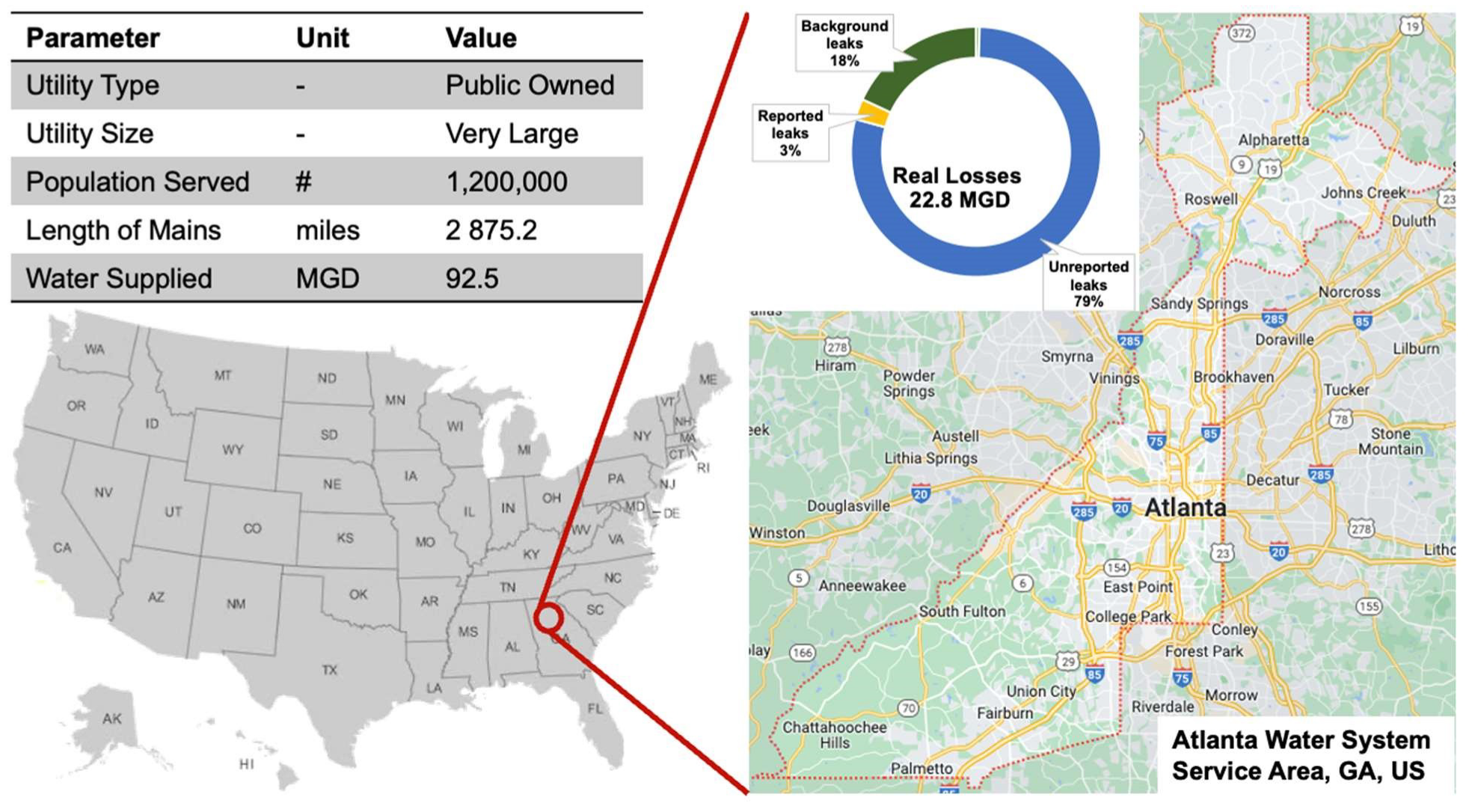

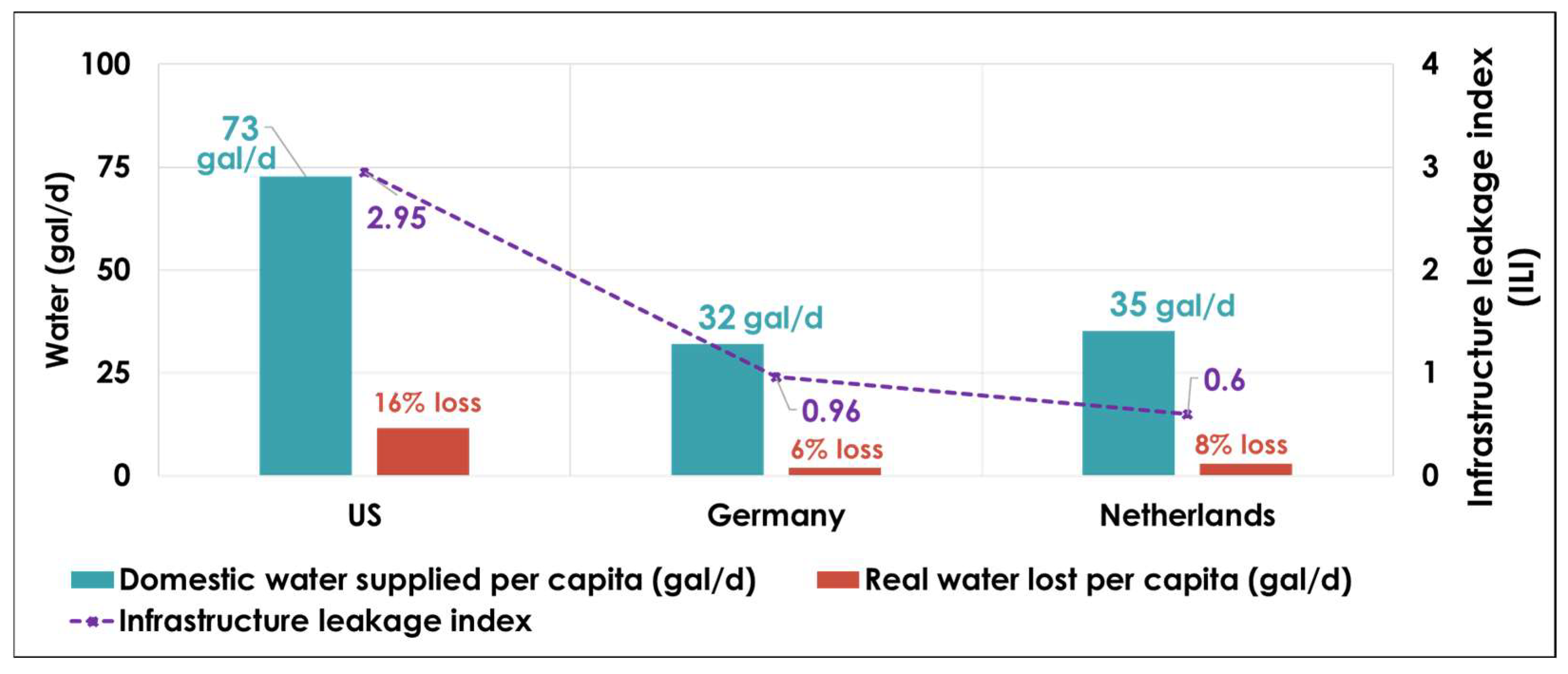
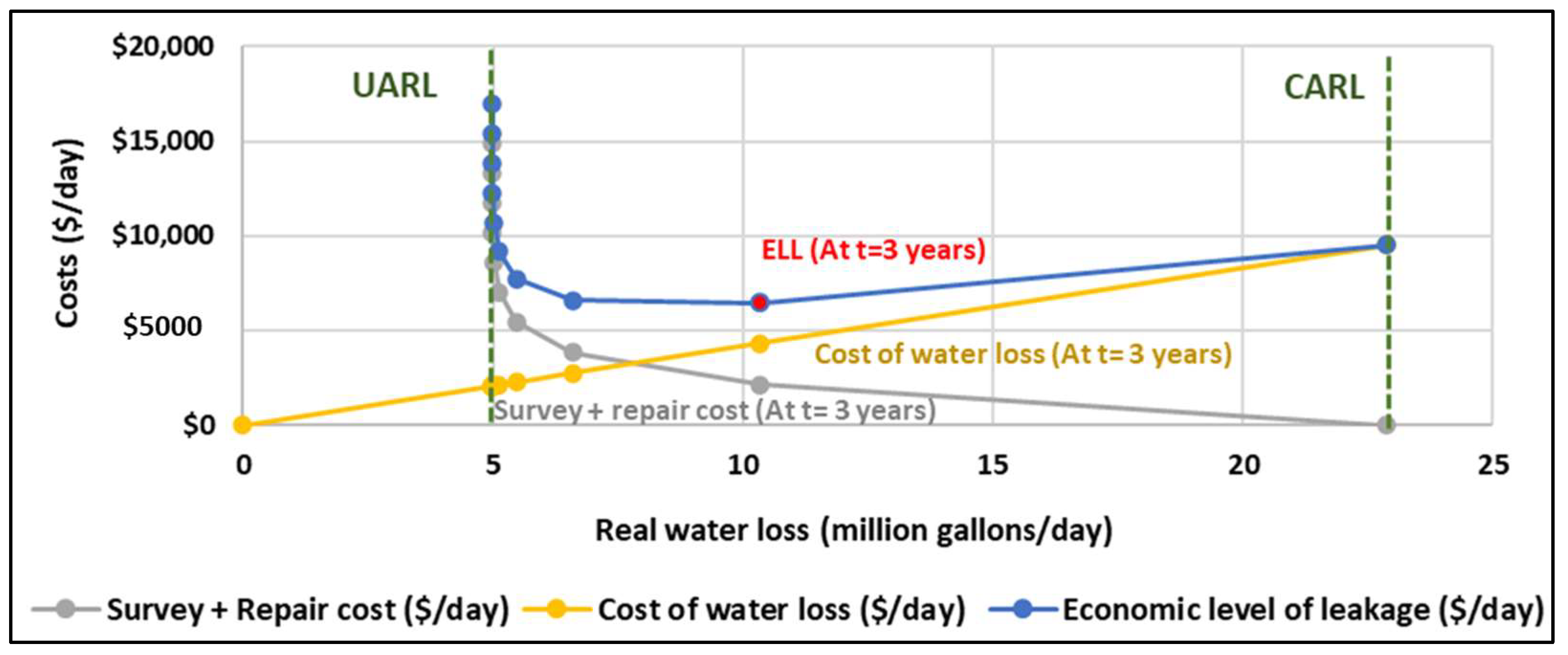
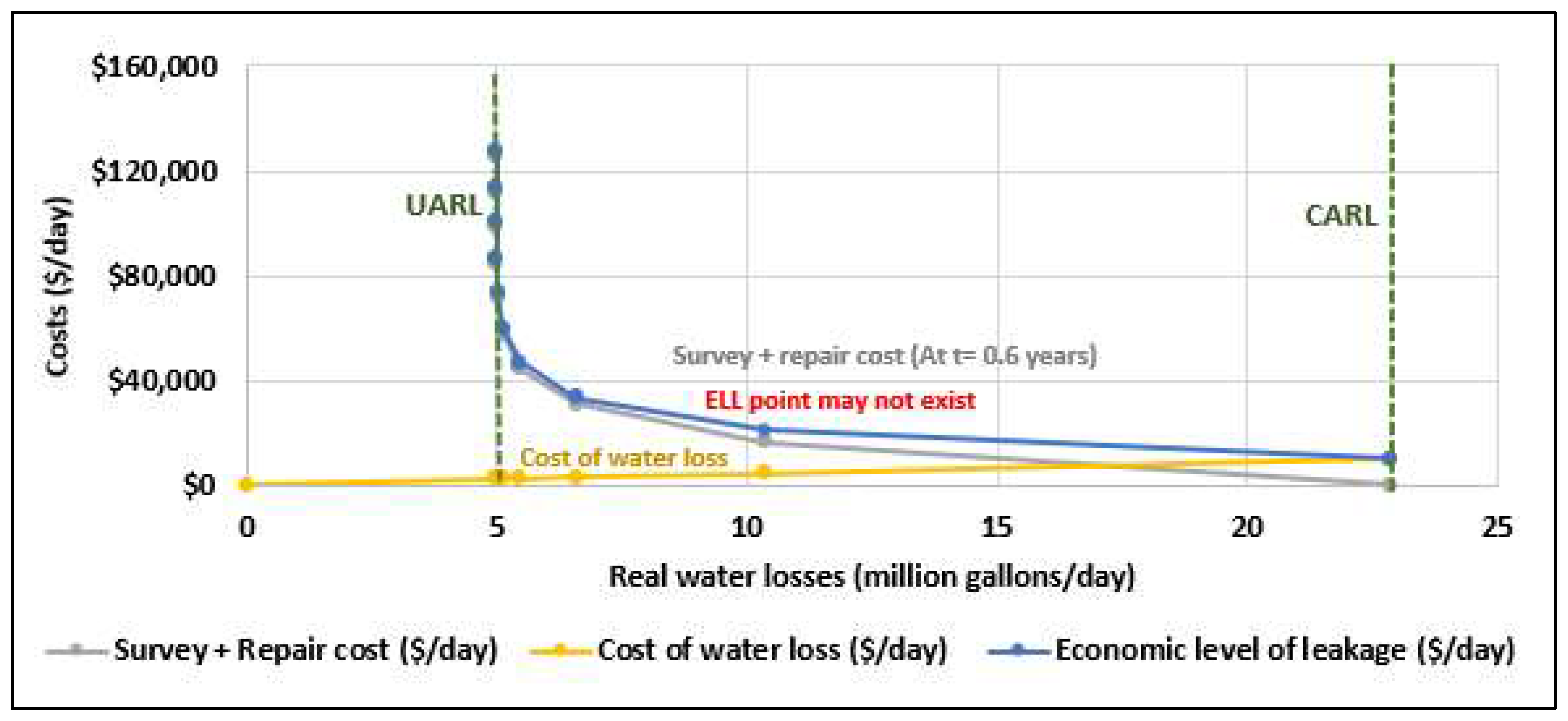
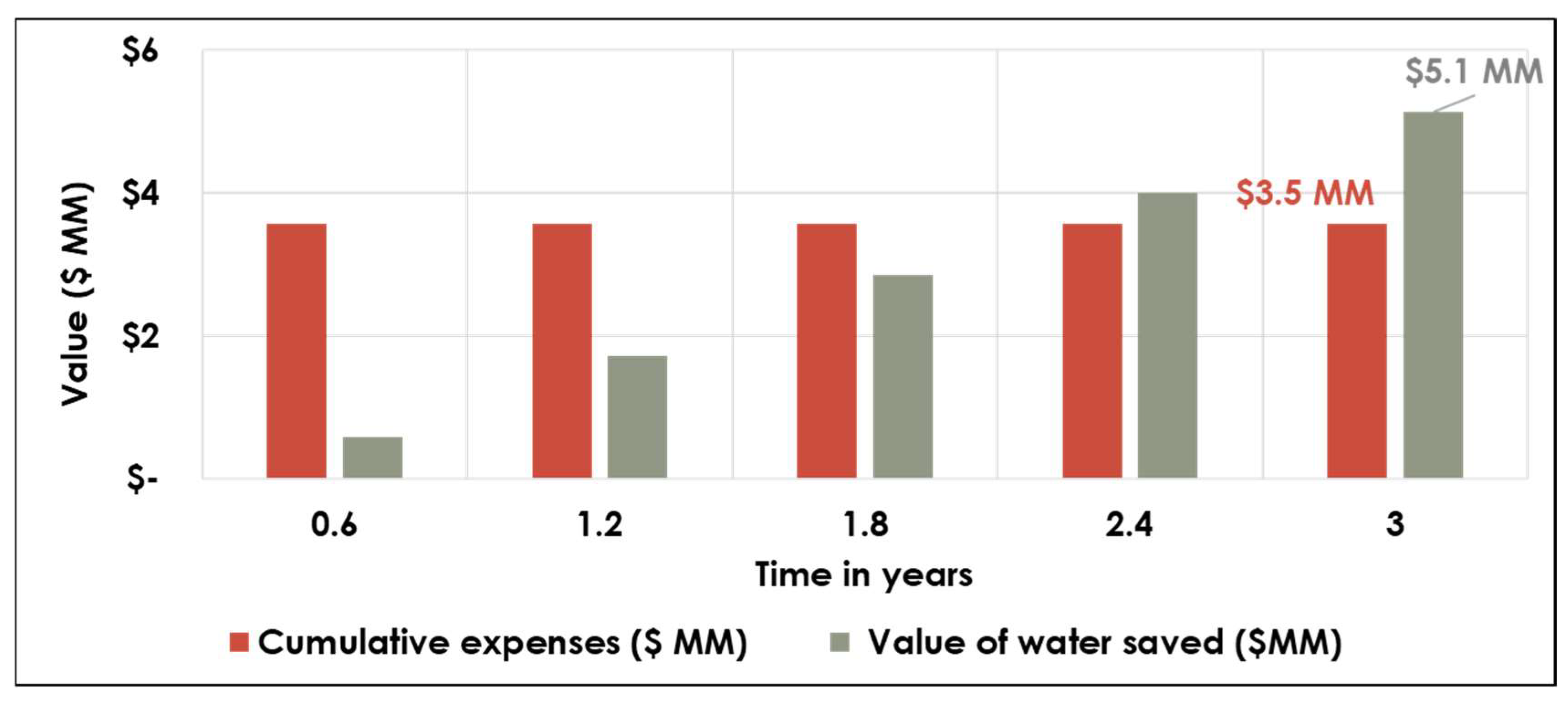
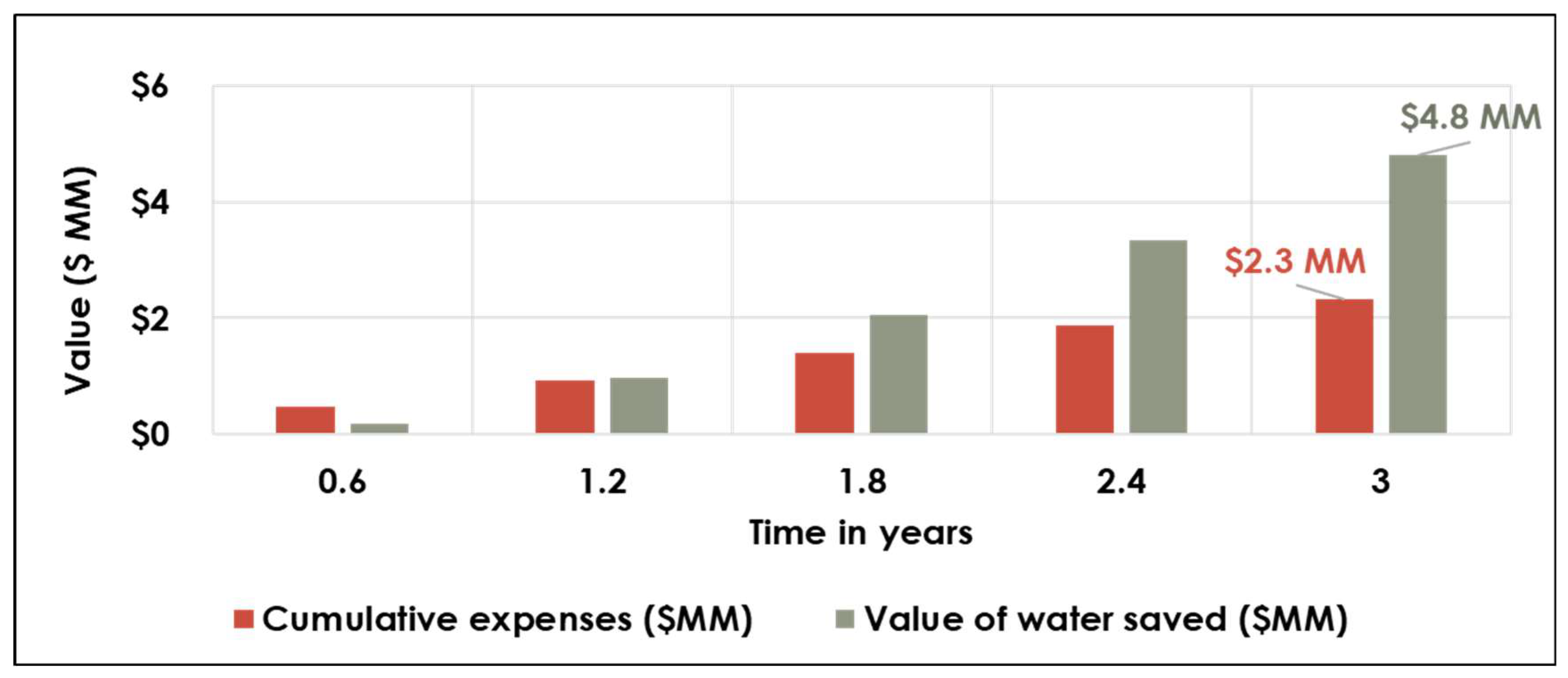
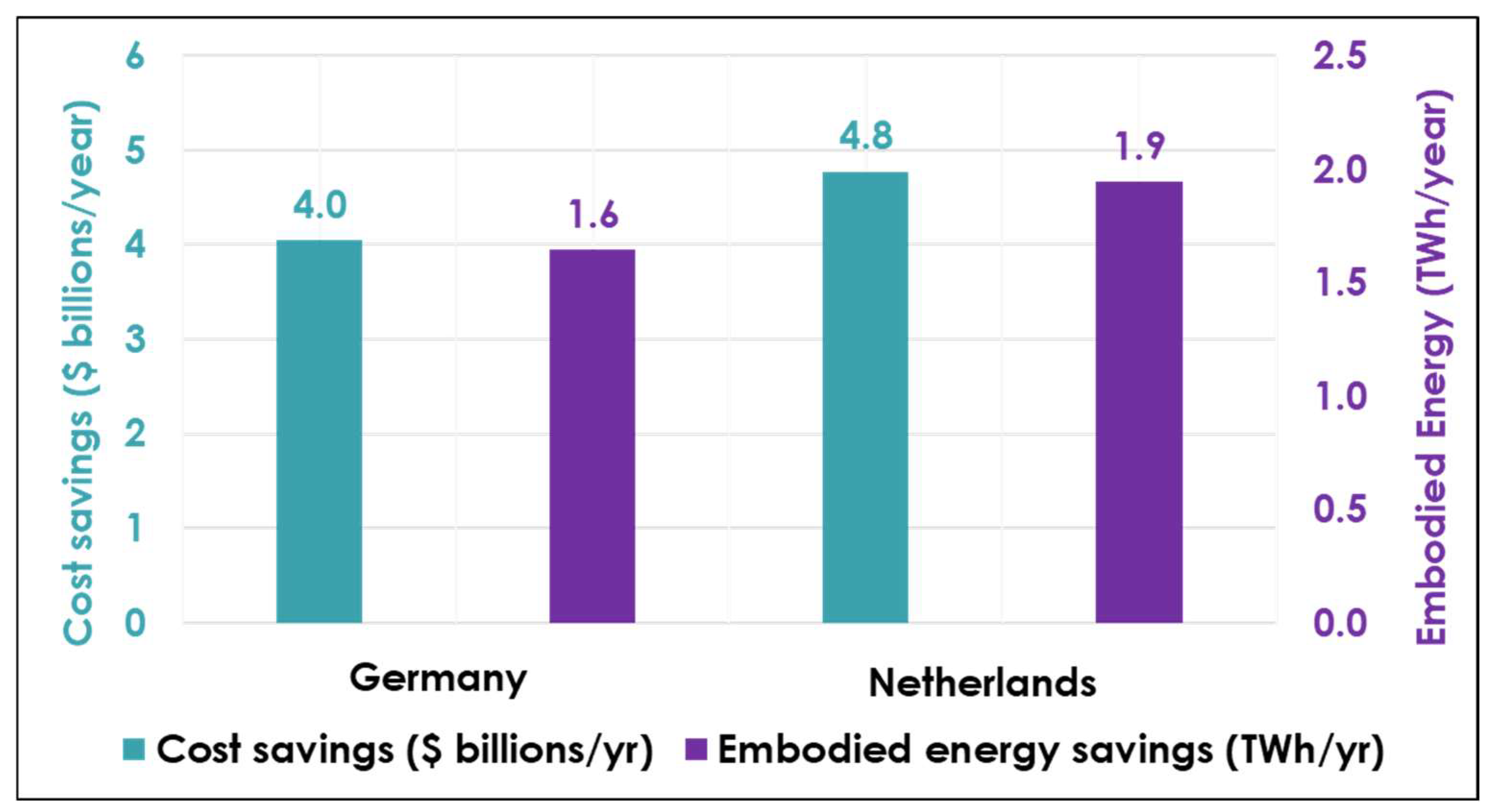
| Method Name | Model Output | Advantages | Shortcomings | Reference |
|---|---|---|---|---|
| Simple economic level of leakage method | Number of surveys, annual cost of leak detection, total water saved annually & costs. | Quick and simple method that can be performed without the need of large level of inputs needing only 9 input parameters. |
| [12] |
| Economic intervention frequency method | Percentage of pipe length that needs to be surveyed; the annual budget needed for intervention. | Quick and simple method that requires variable cost of water ($/m3), estimated cost of intervention ($/mile) and rate of rise (m3/day). |
| [13] |
| Complex economic level of leakage method | Water loss in gallons, cost benefit ratio over 30 years with or without intervention |
|
| [14] |
| Water Leakage Type | Background Leaks | Reported Leaks | Unreported Leaks |
|---|---|---|---|
| Mains | 8.5 gal/mi/h | 0.2 breaks/mi/year at 50 gpm for 3-day duration | 0.01 breaks/mi/year at 25 gpm for 50-day duration |
| Service connections (mains pipe to curb stop) | 0.33 gal/service connection/h | 2.25 leaks/1000 service connections at 7 gpm for 8-day duration | 0.75 leaks/1000 service connections at 7 gpm for 100-day duration |
| Unit | Conventional Acoustic Leak Detection b | Advanced Satellite Leak Detection b,c | |
|---|---|---|---|
| Assumptions for survey estimation costs | |||
| Water mains length | mi | 2875 | |
| Number of service connections | — | 215,426 | |
| Imagery cost | USD/mi | Not applicable | 591 |
| Analysis cost | USD/mi | Not applicable | 591 |
| Physical inspection cost | USD/mi | 595 | 595 a |
| Total survey cost | USD/mi | 595 | 1024 |
| Survey time | years | 3 | 0.6 |
| Leak reduction efficiency per survey | % | 70 | 70 |
| Average operating pressure | psi | 104 | 104 |
| Assumptions for repair estimation costs | |||
| Number of mains leaks in unreported leaks | leaks/mi/year | 0.01 | 0.01 |
| Number of lateral leaks in unreported leaks | leaks/1000 service connections | 0.75 | 0.75 |
| Cost of repairing water mains leaks | USD/leak | 5946 | 5946 |
| Cost of repairing water lateral leaks | USD/leak | 2330 | 2330 |
| Parameter for Comparison | Unit | Conventional Acoustic Technique | Advanced Satellite Leak Detection Technique a |
|---|---|---|---|
| Initial Real Water Losses prior to using leak detection technique | Mgal/day | 23 | |
| Final Real losses at ELL after using leak detection technique | Mgal/day | 10.3 | |
| Total leak detection and repair expenses | USD M | 2.33 | 3.5 |
| Number of leak detection surveys needed at ELL | — | 1 | 1 |
| Value of water savings after first year of survey implementation | USD M/year | 1.9 | 1.9 |
| Water reduction from CARL | % | 55 | 55 |
| New infrastructure leakage index | — | 2.08 | 2.08 |
| Old infrastructure leakage index | — | 4.59 | 4.59 |
| Parameter | Unit | Mean | Standard Deviation | COV |
|---|---|---|---|---|
| Conventional acoustic leak detection technology | ||||
| Number of surveys at ELL | — | 1.8 | 0.5 | 28% |
| Survey and repair costs at ELL | USD/day | 2661 | 600 | 22% |
| Value of water loss at ELL | USD/day | 3311 | 714 | 23% |
| ILI | — | 1.45 | 0.28 | 20% |
| Advanced satellite leak detection technology a | ||||
| Number of surveys | — | 1 | 0 | - |
| Survey and repair costs | USD/day | 37,303 | 7591 | 30% |
| Value of water loss | USD/day | 4884 | 1464 | 20% |
| ILI | — | 2.07 | 0.29 | 14% |
Disclaimer/Publisher’s Note: The statements, opinions and data contained in all publications are solely those of the individual author(s) and contributor(s) and not of MDPI and/or the editor(s). MDPI and/or the editor(s) disclaim responsibility for any injury to people or property resulting from any ideas, methods, instructions or products referred to in the content. |
© 2025 by the authors. Licensee MDPI, Basel, Switzerland. This article is an open access article distributed under the terms and conditions of the Creative Commons Attribution (CC BY) license (https://creativecommons.org/licenses/by/4.0/).
Share and Cite
Nagapurkar, P.; Sharma, N.; Garcia, S.; Nimbalkar, S. Evaluating Acoustic vs. AI-Based Satellite Leak Detection in Aging US Water Infrastructure: A Cost and Energy Savings Analysis. Smart Cities 2025, 8, 122. https://doi.org/10.3390/smartcities8040122
Nagapurkar P, Sharma N, Garcia S, Nimbalkar S. Evaluating Acoustic vs. AI-Based Satellite Leak Detection in Aging US Water Infrastructure: A Cost and Energy Savings Analysis. Smart Cities. 2025; 8(4):122. https://doi.org/10.3390/smartcities8040122
Chicago/Turabian StyleNagapurkar, Prashant, Naushita Sharma, Susana Garcia, and Sachin Nimbalkar. 2025. "Evaluating Acoustic vs. AI-Based Satellite Leak Detection in Aging US Water Infrastructure: A Cost and Energy Savings Analysis" Smart Cities 8, no. 4: 122. https://doi.org/10.3390/smartcities8040122
APA StyleNagapurkar, P., Sharma, N., Garcia, S., & Nimbalkar, S. (2025). Evaluating Acoustic vs. AI-Based Satellite Leak Detection in Aging US Water Infrastructure: A Cost and Energy Savings Analysis. Smart Cities, 8(4), 122. https://doi.org/10.3390/smartcities8040122




